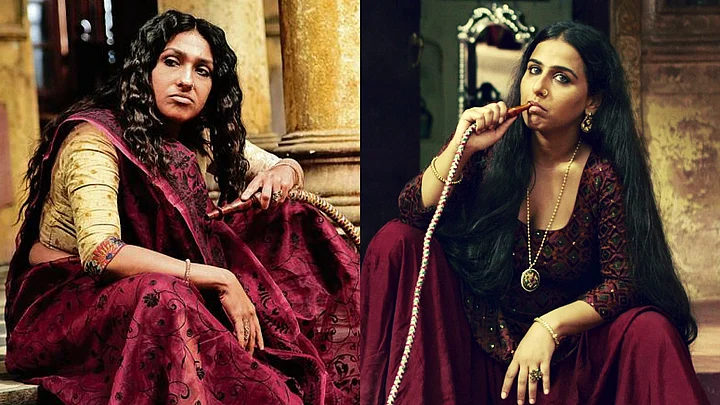Begum Jaan, Srijit Mukherji’s re-creation of his Bengali film Rajkahini, is going to hit theatres across the country on April 14. Vidya Balan plays the madam of a brothel that finds itself divided, as a newly-chalked LOC is drawn between India and Pakistan circa 1947. The trailer featuring the rebellion of a group of female sex-workers against government officials, has attracted much curiosity. Having seen the Bengali original, here’s an attempt on our part to tell you what to expect from the film.
Expect the Expected
Mukherji and his actors are claiming that Begum Jaan is not a remake, but an adaptation. The film’s trailer however, not only recreates multiple shots of the original, but even its dialogues carry an echo of Rajkahini. The characters too, look like xerox copies of the original. The only change is that the Bengali original spoke about Bengal suffering during the Partition, whereas the Hindi version moves itself to pre-partition Punjab, for the obvious convenience of Hindi, and Bollywood’s second language – Punjabi.
Mix Masala
Rajkahini began with doffing its hat to two of Urdu’s accomplished voices, Saadat Hasan Manto and Ismat Chughtai. But Mukherji never acknowledged how much he owed to Buddhadev Dasgupta’s National Award clincher Mondo Meyer Upakhyan (2002), set in a brothel at a specific period in the past (both films even share two actors including the lead, Rituparna Sengupta). The similarities don’t end here. Both films have one common character, that of a local teacher. If Mondo Meyer Upakhyan had a local theatre owner as the dependable man, Mukherji has a Nawab playing a similar role. But for the Hindi audience, Begum Jaan is a clear merger of Shyam Benegal’s Mandi (1983) and Ketan Mehta’s Mirch Masala (1987). Add to that, Lagaan’s (2001) idea of alternate history dealing with mutiny. There you go, Begum Jaan.
Short-changing History
When you talk about the Partition, you’re taking on an event that left millions dead and homeless, one of the defining trials of the last century. The original failed to capture the scale of the tragic experience that displaced countless families. The events that shower in bits and pieces, hardly evoked the horror and palpable tragedy of the ground reality. If it’s not feasible for Bengali films to have massive budgets, Vishesh Films, the producer of Begum Jaan, is known for its controlled spending on production. In short, expect a trickle of people in the name of massive migration, thus short-changing this spectacle of our history.
The Male Gaze
Rajkahini dealt with a group of women in the flesh trade, and the film delved fully into the idea of the women engaging, with outsiders, and within as well. While watching Begum Jaan, keep your eyes open to spot the male gaze, the difference between the gratuitous and provocative, for the original could be held guilty for that.
The Bechdel Test
In a work of fiction, if two or more women talk to each other about something other than a man, it passes the Bechdel test. Hindi films mostly fail in this regard, but Begum Jaan, with its largely female cast will mostly pass it with flying colours. And that’s nothing short of an achievement.
The Larger Question of Patriarchy
If the exterior of Begum Jaan’s brothel is brimming with hatred, the internal picture is a living fantasy of communal harmony. Like Rajkahini, Begum Jaan with women in the core, has a grander question in mind. Be it the British on its way out, or the Hindu-Muslim fighting for their own pie in newly formed nations, it’s always men who rule. Though watered down, this will be a clear cut suffragette take on the masculine system.
Historical Fantasy
Begum Jaan will continue the tradition of historical fantasy that Bollywood favours to sell tickets. Like the original, this will play out an imagined resistance against a bureaucratic irrationality, a counterfactual version of the past like Quentin Tarantino’s Inglourious Basterds (2009). But Mukherji is no Tarantino. So when you watch Begum Jaan, ask yourself this simple question – is the traumatic event of the Partition a mere set-up to play out this fantasy of sex and violence? Or is it justified with its set-up of women, the boiling cauldron class and caste, and their experiences? Something subaltern doesn’t necessarily lend it the air of honesty, don’t we all know?
Stagey Dialogues and Cakey Make-Up
The original itself suffered from stagey dialogues and unintended pauses for effect. Thankfully, Begum Jaan’s dialogues are credited to Kausar Munir, and it will be interesting to see how much dialoguebaazi can conjure the pain, loss and above all, the rage of the characters. About cakey looks, it seems there’s no escape. Did you see the trailer?
The Impetus
Begum Jaan is the madam who keeps harping on the need to draw business, for they should be practical sex-workers. Despite being vulnerable to humiliation and violence, with an overwhelming exodus looming large, Rajkahini didn’t provide enough motivation for its lead players. Would their business remain once the migration starts? This was a question the Bengali original didn’t bother to probe. Will the Hindi version improve on this? Only Friday will tell.
(The writer is a journalist and a screenwriter who believes in the insanity of words, in print or otherwise; he tweets @RanjibMazumder)
Join The Quint on WhatsApp. Type “JOIN” and send to 9910181818
